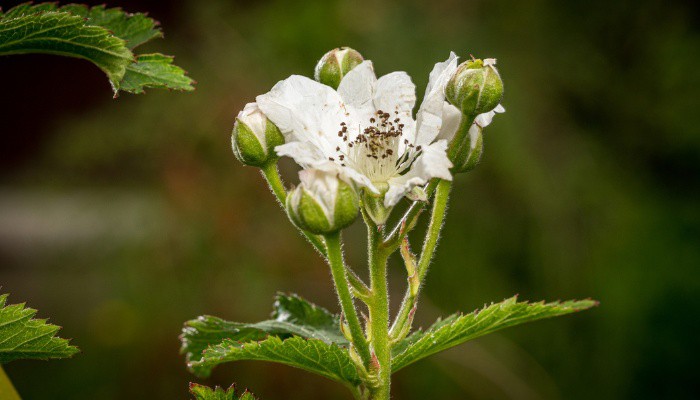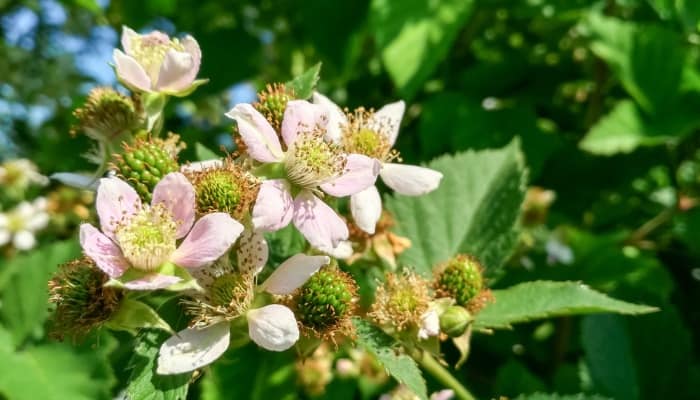Blackberries have been utilized as a source of nourishment and healing for many cultures across the globe for centuries, thanks to their abundant supply of vitamins and nutrients.
Several wild blackberry species originate in the temperate forests of North America. Other domesticated varieties have since crossed the Atlantic to be cultivated on U.S. grounds.
No matter their native soils, this assortment of species gives gardeners many tasty options.
Blackberries begin to flower between mid-spring to early summer, depending on the variety, local climate, and other environmental conditions. In warmer climates, blooms can be as early as March while in colder climates, flowering could be delayed until June.
Once established, blackberries are a low-maintenance perennial plant that can provide nutritious fruits and a bountiful harvest. The sweet scent of their tiny blooms can also attract pollinators to your edible landscape. Win-win.
Dive into the details of blackberries and their flowering schedule below.
Blackberry Blooming Time
Blackberries thrive in USDA Hardiness Zones 5 to 10. Some types of blackberries start blooming from mid-April to early May in warmer regions below Zone 7. Sometimes blooms are known to appear in March near Zone 10.
In colder areas, specifically Plant Hardiness Zones 5 and 6, the flowers wait until late May to June to show their white and pink petals.
Factors That Influence Blackberry Blooming
There are multiple factors that impact blooming times across the U.S. These include variety, location, and other environmental factors.
Blackberry Variety
Blackberry varieties vary in their growth patterns, fruit size and shape, and ideal conditions. The main types are erect, semi-erect, and trailing plants.
- Erect blackberries support themselves and can be of the thorny or thornless variety.
- Trailing blackberries need trellised support.
- Semi-erect varieties fall in between, requiring some support. They can be either thorny or thornless.
Some varieties will bloom as early as March, and others will bloom later in spring or early summer months. However, the timing of when blooms appear is heavily dependent on the weather.
Growing Region & Temperature
Blackberries are hardy plants, capable of growing across the United States without much intervention.
Erect blackberry varieties are equipped to survive the harsh winters in the northern regions while trailing plants prefer the warm sunshine in the South.
Your USDA Zone and the current temperatures have a direct impact on when blooming will occur. The farther north you live, the later the bloom time you can expect to see, and a particularly chilly spring can delay blooming even further.
Growing Conditions
Poor or depleted soil will not support vigorous growth and blooming as the blackberries will not have access to the nutrients they need.
Blackberries growing in areas with inadequate sunlight will struggle to bloom or may experience delayed blooming. Drought conditions can also stress the plant and force it to direct energy toward survival rather than blooming.
Ideal conditions for most blackberries are a mild spring with a warm, sunny summer. If the conditions are too hot, then flowers can drop early and decrease yield. Frost can also decrease yield by damaging sensitive buds.
Factors such as humidity can promote the spread of disease, which can also delay blooming or even prevent it entirely.
Do Blackberries Bloom the First Year?
The simple answer is no. For most blackberries, the fruits only grow on two-year-old canes.
Sometimes there is a small yield of fall berries in the first season; however, it is best practice to prune these as flowers to allow the bush to become established. The rare exception to this pattern is the primocane-fruiting blackberries.
Do Blackberries Bloom More Than Once?
As perennial shrubs, once established, blackberry bushes will bloom on an annual basis. However, each individual cane will only bloom once in its second year, then it will not produce drupelets again.
Luckily, the bushes produce new shoots each year to start blooming and produce fruits the following spring.
How Long Do Blackberry Flowers Last?
The flowering stage lasts 45 to 60 days before producing juicy fruits. Blooms attract pollinators to your garden. Once pollinated, the petals wither to make way for the drupelets.

Blackberry USDA Hardiness Zones
The USDA Hardiness Zones are a system developed by the United States Department of Agriculture to categorize and define the climate conditions in different regions of the United States.
These zones are based on average annual minimum winter temperatures and are used to help gardeners and farmers determine which plants are likely to thrive in their specific area.
For blackberries, it’s important to choose varieties that are suitable for your specific USDA Hardiness Zone to ensure they can withstand the winter temperatures in your region. Here’s a basic breakdown of the USDA Hardiness Zones for blackberries:
- Zone 3: This zone experiences very cold winters with minimum temperatures dropping as low as -40°F (-40°C). It’s challenging to grow blackberries in this zone, and if you want to attempt it, you’ll need to select varieties that are exceptionally cold-hardy.
- Zone 4: This zone also experiences cold winters with minimum temperatures ranging from -30°F to -20°F (-34°C to -29°C). You’ll need to choose blackberry varieties that can withstand these low temperatures.
- Zone 5: This zone experiences cold winters with minimum temperatures ranging from -20°F to -10°F (-29°C to -23°C). Blackberries that are suited for Zone 5 should be able to handle these winter conditions.
- Zone 6: This zone has milder winters compared to Zones 3, 4, and 5, with minimum temperatures ranging from -10°F to 0°F (-23°C to -18°C). You have a wider selection of blackberry varieties to choose from in this zone.
- Zone 7: This zone experiences relatively mild winters, with minimum temperatures ranging from 0°F to 10°F (-18°C to -12°C). Most blackberry varieties should thrive in this zone.
- Zone 8: This zone has mild winters, with minimum temperatures ranging from 10°F to 20°F (-12°C to -7°C). Blackberries generally do well in this zone.
- Zone 9: This zone experiences very mild winters, with minimum temperatures ranging from 20°F to 30°F (-7°C to -1°C). Blackberries thrive in this zone and have a long growing season.
- Zone 10: This zone has very warm winters, with minimum temperatures ranging from 30°F to 40°F (-1°C to 4°C). Blackberries can be grown year-round in this zone.
- Zone 11: This zone has tropical climates with very mild winters, with minimum temperatures above 40°F (4°C). Blackberries can be grown year-round in this zone.
Are Blackberries Self-Pollinating?
Blackberries are considered self-fertile in that they can produce berries without having another variety nearby.
They are, to a degree, self-pollinating in that pollination can occur without the assistance of pollinators, but the activity of pollinators such as bees results in better pollination and larger, tastier fruits.
Planting several plants together provides more pollen for bees and results in better pollination for each plant. Different varieties can be grown together to increase the pollination rate and yield larger, sweeter fruits.
How Blackberries Produce Fruit
Once flowers are pollinated, the fertilized ovules develop into seeds. These swell to create a fruit, which is a collection of small seeds called drupelets. The first stage of the fruit is a dense, green cluster with its petals slowly dying back.
Next, the drupelet turns pink and extends to a longer fruit. Lastly, the fruit begins to fill with juice, darkening into a black, plump snack ready to harvest. This transformation from bloom to fruit takes approximately two months.
Blackberry Canes: Primocanes vs. Floricanes
Blackberry shoots or “branches” are known as canes. There are two types of canes: primocanes and floricanes. In their first year, new canes are called primocanes, and they do not bear fruit.
Primocanes focus on vegetative growth and develop buds late in the season before going dormant. Without maintenance, these beginner canes can reach several feet tall.
When spring arrives, the dormant primocanes from last year awaken and are now known as floricanes. These woodier canes bloom in the spring of their second year, fruit in the mid-summer, then die back after harvest.
Both primocanes and floricanes grow on mature plants, ensuring an annual blackberry yield. They require separate care for optimal fruit production.
How To Prune Blackberry Plants for Optimal Fruit Production
Blackberry pruning is the key to a successful harvest. The correct cuts will improve fruit yield, reduce overgrowth, and create stronger plants.
A spring trim of the primocanes will improve yield by providing space to grow. First-year blackberry shoots should be thinned to about six canes per plant. Damaged and diseased canes should always be removed.
These primocanes should also be trimmed at the tips to encourage branching. The more branches, the more fruits.
After harvest, trim the floricanes to the ground to promote spring growth and prevent tangled sprouts. These second-year shoots will not fruit again and will only take up valuable garden space.
If you are growing primocane-fruiting blackberries, you can cut back the entire plant each winter.
When Do Blackberries Ripen?
July and August are prime months to pick ripe blackberries, but in some climates, picking season can extend to early September. Upon ripening, the drupelets will transition to a glossy black. The shape will fill out into a soft, plump fruit.
Be patient. Blackberries will not ripen further after harvest, so pick wisely.
How To Harvest & Store Blackberries
Because there is a short harvest period, it is important to be ready to pick and preserve ripened blackberries. Due to their moisture content, it is best practice to pick the fruits in the cool mornings.
Make sure to wear some sturdy gloves if working with a thorned variety. Once harvest begins, prepare to pick berries at least once a week.
As highly perishable fruits, fresh blackberries need to be refrigerated after harvest and consumed within three to six days. They are also delicate. To prevent bruising, lay the berries in a single layer, if possible. This will prolong their freshness.
However, there are other ways to enjoy and store your harvest, such as freezing or canning the berries for future use.
How To Increase Blackberry Production
With some help, your blackberry yield can explode with sweet fruits.
- Select a site with full sun and good drainage.
- Prune the first flowers on primocanes to create stronger canes the following season.
- Plant beneficial companions to attract additional pollinators and bees to the sweet blackberry blooms.
- Mulch around the plants to retain moisture. Blackberries love a moist environment. Compost makes an ideal mulch because it improves the soil and provides a slow release of nutrients.
- Fertilize in the early spring with an all-purpose balanced fertilizer.
Related Questions:
Do Blackberries Come Back Year After Year?
All blackberries are perennial, meaning the plant will come back year after year, especially with the correct pruning techniques mentioned above.
Though their roots are able to survive the winters beneath the soil, the vegetation above does not. However, after the initial year of no fruits, these bushes will yield drupelets for years to come with the proper care.
Do You Cut Blackberries Down Every Year?
The two-year-old floricanes should be removed every year to ensure another plentiful harvest. Pruning the old canes to the ground leaves room and resources for the primocanes the following season.
Primocane-bearing blackberries can be cut to the ground each year in winter.
Final Thoughts
Blackberries, with their juicy berries, are the perfect addition to any garden. There are many options for every taste preference and for each garden’s needs. With the right care, blackberries can continue to bloom and fruit for 15 to 20 years.

